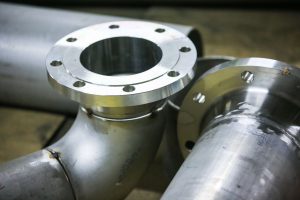
Because each type of metal has its own limitations and provides its own unique benefits the choice of material for a pressure vessel will largely depend on the specific needs of the intended application. Failing to select the right material is a leading cause of pressure vessel failure. This is why selecting the appropriate metal for a specific application is critical.
Improper selection can lead to a number of serious issues from poor performance and lower efficiency to reduced safety and ultimately catastrophic failure. It is mandated by the National Board of Boilers and Pressure Vessel Inspectors that a test report be provided when any pressurised tank is ordered.
However, this has not been totally effective enough at preventing errors from occurring in the certification procedure and as a result, incorrect selection of pressure vessel materials remains commonplace.
There are a number of different types of materials used in pressure vessel manufacturing, including carbon steel, stainless steel, Hastelloy, nickel alloy, aluminium, and titanium. Given the fact that failure of pressurised vessels can create a significant hazard that often leads to more downtime, higher production costs, and, most importantly, reduced safety – engaging a reputable manufacturer to help select the right material for a specific pressure vessel is crucial.
What are Pressure Vessels?
Pressure vessels are solid, leak-proof containers, usually cylindrical or spherical in shape, designed to hold fluids such as gases or liquids at pressures that are significantly different from the ambient pressure. The most common materials used for pressure vessels are carbon or stainless-steel plates rolled into shape and welded together to form a tank.
Pressure vessels are essential for providing temporary storage, for example, for compressed air, before it is utilised. In addition, it helps a compressor system to run more efficiently. In a compressed air system a pressure vessel performs 3 primary functions:
- Temporarily stores compressed air until there is a demand for it
- Provides steady air signs for air compressor controls
- In wet pressure vessels, they play a secondary role in heat exchangers by enhancing the efficiency of the air dryer.
Different Types of Pressure Vessels
In general, there are three main types of pressure vessels – horizontal, vertical, and spherical. A few examples of the most widely used pressure vessels include:
- Columns
- Towers
- Boilers
- Separators
- Bullet tanks
- Heat exchangers
- Knock-out drums
- Reactors
All of these pressure vessels have varying temperatures and operating pressures and are extensively used in chemical/petrochemical processing, petroleum refining, oil and gas industries, and power plants.
Top Material Ideal for the Manufacturing of Pressure Vessels
The top four materials that are ideal for the manufacture of pressure vessels are:
Stainless Steel
The robust design and construction of stainless steel make it an ideal material for pressure vessels. Stainless steel grades have the best corrosion-resistant properties and are highly resistant to a wide range of chemicals. It is economical and ideal for use in high temperatures or humid conditions.
Titanium
Titanium’s many properties make it suitable for use in a pressure vessel. It has a great capability to retain its own structural integrity, is highly resistant to corrosion, and is ideal for use with harsh liquids like acids. It is non-toxic, low maintenance, and economical.
Aluminium
Aluminium’s tensile strength is its most beneficial attribute. It is more cost-effective compared to other materials in the range and has a slightly higher coefficient expansion compared to other alternatives.
Nickel Alloy
Nickel Alloy is the perfect material for the protection of both the constituents and the vessel from thermal expansion. With perfect resistance to corrosion, its oxidation and carburisation levels are perfect for pressure vessels. It can be relied on in hostile surroundings and is longer lasting than most other materials.
Choosing the Right Material for Your Pressure Vessel
The right material for your pressure vessel will largely depend on the type of vessel you will be using and the type of constituents it will be required to contain. The above four examples are an indication of each material’s qualities and features and could serve as a guide, however, it is highly recommended to obtain the professional advice of a trusted manufacturer of pressure vessels to avoid making any mistakes.
The design of a pressure vessel must be undertaken with great care as these tanks operate under tremendous pressure and a ruptured vessel can cause extensive and sometimes irreversible damage to property and harm to mankind. The ASME Sec VIII code is there to govern the design of pressure vessels. Pressure vessels can be custom designed and manufactured according to your specific requirements.
Registering a Pressure Vessel Design
The process of design verification and registration of pressure vessels is to ensure that the design meets the minimum requirements of the nominated international standard for the stated design and operating conditions. The process is concerned more with the safety of the equipment than its functionality. If your vessel has a hazard level of A, B, C, or D, it is mandatory to register the design. Failing to do this means that you can be liable for a fine.
At Sherwood Design and Engineering our highly qualified engineers design and manufacture pressure vessels to the Australian Standard AS 1210 code. We can recommend a Pressure Vessel Engineer to inspect the final design and sign off for Item Registration before the vessel is put into service.
Give us a call at (02) 9437 3566 or leave an enquiry if you would like to learn more about our pressure vessel engineering design and support services.
